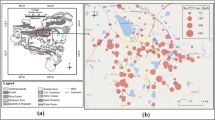Abstract
Spatial distribution of radon in groundwater in the coastal tracts of southern Kerala, India was studied to understand its linkage with the monazite bearing beach sand deposits in the area. The mean radon concentrations were below the guideline value recommended by United States Environmental Protection Agency in about 94 % samples analyzed. Annual effective ingestion and inhalation doses of water-borne radon were found to be well below the average doses reported from all natural sources. The study indicated that radionuclides in the monazite-rich beach sands do not contribute significantly to the radon concentration in groundwater in the area.



Similar content being viewed by others
References
Ragheb M (2011) Nuclear, plasma and radiation science. Inventing the future—chapter 4—environmental radiation. http://mragheb.com/NPRE%20402%20ME%20405%20Nuclear%20Power%20Engineering/Environmental%20Radiation.pdf); Accessed 11 Apr 2015
Duenas C, Fernandez MC, Carretero J, Liger E, Canete S (1999) 226Ra and 222Rn concentrations and doses in bottled waters in Spain. J Environ Radioact 45:283–290
U.S. Environmental Protection Agency (1992a) A citizen’s guide to radon—the guide to protecting yourself and your family from radon: EPA 402-K92-001, p 15
Akawwi E (2014) Radon-222 concentrations in the groundwater along Eastern Jordan Rift. J Appl Sci 14:309–316
United Nations Scientific Committee on the Effects of Atomic Radiation (UNSCEAR) (2000) Sources, effects and risks of ionizing radiations. UNSCEAR, New York
Cook PG, Favreau G, Dighton JC, Tickell S (2003) Determining natural groundwater influx to a tropical river using radon, chlorofluorocarbons and ionic environmental tracers. J Hydrol 277:74–88
Ellins KK, Romanmas A, Lee R (1990) Using Rn-222 to examine groundwater-surface discharge interaction in the Rio-Grande-de-Manati, Puerto-Rico. J Hydrol 115:319–341
Genereux DP, Hemond HF, Mulholland PJ (1993) Use of Rn-222 and calcium as tracers in a 3-end-member mixing model for streamflow generation on the west fork of Walker branch watershed. J Hydrol 142:167–211
Hamada H (1999) Analysis of the interaction between surface water and groundwater using radon-222. Jpn Agric Res Q 33(4):261–265
Hamada H (2000) Estimation of groundwater flow rate using the decay of Rn-222 in a well. J Environ Radioact 47(1):1–13
Macheleidt W, Nestler W, Grischek T (2002) Determination of hydraulic boundary conditions for the interaction between surface water and groundwater. Spec Publ Geol Soc Lond 193:235–243
Mullinger NJ, Binley AM, Pates JM, Crook NP (2007) Radon in chalk streams: spatial and temporal variation of groundwater sources in the Pang and Lambourn catchments, UK. J Hydrol 339:172–182
Lee JM, Kim G (2006) A simple and rapid method for analysing radon in coastal and groundwaters using a radon-in-air monitor. J Environ Radioact 89:219–228
Dytham C (2011) Choosing and using statistics: a biologist’s guide, 3rd edn. Wiley-Blackwell, Chichester
Helsel DR, Hirsch RM (2002) Statistical methods in water resources—techniques of water resources investigations, book 4, chapter A3. U.S. Geological Survey, Reston
Krishan G, Rao MS, Kumar CP, Semwal Prabhat (2015) Radon concentration in groundwater of east coast of West Bengal, India. J Radioanal Nucl Chem 303:2221–2225
Wu Y-Y, Ma Y-Z, Cui H-X, Liu J-X, Sun Y-R, Shang B, Xu S (2014) Radon concentrations in drinking water in Beijing City, China and contribution to radiation dose. Int J Environ Res Public Health 11:11121–11131
United Nations Scientific Committee on the Effects of Atomic Radiation (UNSCEAR) (1993) Sources and effects of ionizing radiation. UNSCEAR, New York
World Health Organization (WHO) (2011) Guidelines for drinking-water quality. In: Radiological aspects, 4th edn. WHO, Geneva
Mineral Resources. http://dmg.kerala.gov.in/index.php?option=com_content&view=article&id=55&Itemid=61. Accessed 15 Apr 2015
Das B (2010) Genetic studies on human population residing in high level natural radiation areas of Kerala coast. BARC Newsl 313:28–37
Virk HS, Walia V, Bajwa BS (2001) Radon monitoring in underground water of Gurdaspur and Bathinda districts of Punjab, India. Indian J Pure Appl Phys 39:746–749
Duggal V, Asha R, Rohit M (2012) In situ measurements of radon levels in groundwater in Northern Rajasthan, India. Adv Appl Sci Res 3(6):3825–3830
D’Cunha P, Narayana Y, Karunakara N, Yashodhara I, Kumara S (2011) Concentration of 222Rn in drinking water along coastal Kerala and evaluation of ingestion doses. Radiat Prot Environ 34:197–200
United Nations Scientific Committee on the Effects of Atomic Radiation (UNSCEAR) (1988) Sources, effects and risks of ionizing radiation. Report to the general assembly, United Nations, New York
Acknowledgments
The authors wish to express their sincere gratitude to Shri Sushil Gupta, Chairman (Retd.), Central Ground Water Board for granting permission to conduct the study and to Dr. R C Jain, Member (SAM) (Retd.) and Shri K Md. Najeeb, Member (TT & WQ) (Retd), Central Ground Water Board, Government of India, for their encouragement. They are thankful to Shri K B Biswas, Chairman, Central Ground Water Board for granting permission for publication of this paper and Dr.Dipankar Saha, Member (RGI), for suggestions to improve the paper. Thanks are also due to the Regional Director, CGWB, South Western Region, Bengaluru for making the RAD 7 instrument available for the study and to all colleagues for their help and cooperation during the study and preparation of the paper. The anonymous reviewers are thanked for their meticulous reviews, which have helped improve the quality of the paper.
Author information
Authors and Affiliations
Corresponding author
Rights and permissions
About this article
Cite this article
Nandakumaran, P., Vinayachandran, N., Anitha Shyam, T.S. et al. Radon in groundwater in parts of coastal tracts of southern Kerala, India. J Radioanal Nucl Chem 308, 99–104 (2016). https://doi.org/10.1007/s10967-015-4272-5
Received:
Published:
Issue Date:
DOI: https://doi.org/10.1007/s10967-015-4272-5




